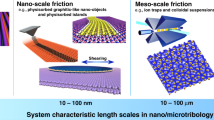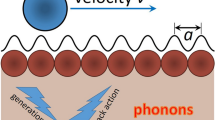Abstract
The mechanical behaviour of molecular machines differs greatly from that of their macroscopic counterparts. This applies particularly when considering concepts such as friction and lubrication, which are key to optimizing the operation of macroscopic machinery. Here, using time-resolved vibrational spectroscopy and NMR-lineshape analysis, we show that for molecular machinery consisting of hydrogen-bonded components the relative motion of the components is accelerated strongly by adding small amounts of water. The translation of a macrocycle along a thread and the rotation of a molecular wheel around an axle both accelerate significantly on the addition of water, whereas other protic liquids have much weaker or opposite effects. We tentatively assign the superior accelerating effect of water to its ability to form a three-dimensional hydrogen-bond network between the moving parts of the molecular machine. These results may indicate a more general phenomenon that helps explain the function of water as the ‘lubricant of life’.
This is a preview of subscription content, access via your institution
Access options
Subscribe to this journal
Receive 12 print issues and online access
$259.00 per year
only $21.58 per issue
Buy this article
- Purchase on Springer Link
- Instant access to full article PDF
Prices may be subject to local taxes which are calculated during checkout




Similar content being viewed by others
References
Cnossen, A. et al. Driving unidirectional molecular rotary motors with visible light by intra- and intermolecular energy transfer from palladium porphyrin. J. Am. Chem. Soc. 134, 17613–17619 (2012).
Hirose, K. Molecular brake systems controlled by light and heat. J. Inclusion Phenom. Macrocyclic Chem. 68, 1–24 (2010).
Ray, D., Foy, J. T., Hughes, R. P. & Aprahamian, I. A switching cascade of hydrazone-based rotary switches through coordination-coupled proton relays. Nature Chem. 4, 757–762 (2012).
Kubo, R., Toda, M. & Hashitsume, N. Statistical Physics II. Nonequilibrium Statistical Mechanics (Springer, 1985).
Braun, O. & Naumovets, A. Nanotribology: microscopic mechanisms of friction. Surf. Sci. Rep. 60, 79–158 (2006).
Barron, L. D., Hecht, L. & Wilson, G. The lubricant of life: a proposal that solvent water promotes extremely fast conformational fluctuations in mobile heteropolypeptide structures. Biochemistry 36, 13143–13147 (1997).
Kay, E. R., Leigh, D. A. & Zerbetto, F. Synthetic molecular motors and mechanical machines. Angew. Chem. Int. Ed. 46, 72–191 (2007).
Panman, M. R. et al. Operation mechanism of a molecular machine revealed using time-resolved vibrational spectroscopy. Science 328, 1255–1258 (2010).
Brouwer, A. M. et al. Photoinduction of fast, reversible translational motion in a hydrogen-bonded molecular shuttle. Science 291, 2124–2128 (2001).
Gatti, F. G. et al. Photoisomerization of a rotaxane hydrogen bonding template: light-induced acceleration of a large amplitude rotational motion. Proc. Natl Acad. Sci. USA 100, 10–14 (2003).
Horng, M., Gardecki, J. & Maroncelli, M. Rotational dynamics of coumarin 153: time-dependent friction, dielectric friction, and other nonhydrodynamic effects. J. Phys. Chem. A 101, 1030–1047 (1997).
Jagesar, D. C. et al. Photoinduced shuttling dynamics of rotaxanes in viscous polymer solutions. Adv. Funct. Mater. 19, 3440–3449 (2009).
Henson, D. B. & Swenson, C. A. Infrared spectroscopic studies of N,N-disubstituted amides as models for the peptide bond in hydrogen bonded interactions with water molecules. J. Phys. Chem. 77, 2401–2406 (1973).
Minzuno, K. et al. Studies of the interaction between alcohols and amides to identify the factors in the denaturation of globular proteins in halogenalcohol + water mixtures. J. Chem. Soc. Faraday Trans. 80, 879–894 (1984).
Torii, H., Tatsumi, T., Kanazawa, K. & Tasumi, M. Effects of intermolecular hydrogen-bonding interactions on the amide I mode of N-methylacetamide: matrix-isolation infrared studies and ab initio molecular orbital calculations. J. Phys. Chem. B 102, 309–314 (1998).
Wintgens, V., Valat, P. & Kossanyl, J. Spectroscopic properties of aromatic dicarboximides: part 1. –N–H and N-methyl-substituted naphthalimides. J. Chem. Soc. Faraday Trans. 90, 411–421 (1994).
Jagesar, D. C., Hartl, F., Buma, W. J. & Brouwer, A. M. Infrared study of intercomponent interactions in a switchable hydrogen bonded rotaxane. Chem. Eur. J. 14, 1935–1946 (2008).
Sundaralingam, M. & Sekharudu, Y. C. Water-inserted α-helical segments implicate reverse turns as folding intermediates. Science 244, 1333–1337 (1989).
Nucci, N. V., Pometun, M. S. & Wand, A. J. Site-resolved measurement of water–protein interactions by solution NMR. Nature Struct. Mol. Biol. 18, 245–250 (2011).
Xu, F. & Cross, T. A. Water: foldase activity in catalyzing polypeptide conformational rearrangements. Proc. Natl Acad. Sci. USA 96, 9057–9061 (1999).
Kamlet, M., Abboud, J., Abraham, M. & Taft, R. Linear solvation energy relationships. 23. A comprehensive collection of the solvatochromic parameters, π*, α, β, and some methods for simplifying the generalized solvatochromic equations. J. Org. Chem. 48, 2877–2887 (1983).
Mazur, K., Heisler, I. A. & Meech, S. R. Ultrafast dynamics and hydrogen-bond structure in aqueous solutions of model peptides. J. Phys. Chem. B 114, 10684–10691 (2010).
Mazur, K., Heisler, I. A. & Meech, S. R. Water dynamics at protein interfaces: ultrafast optical Kerr effect study. J. Phys. Chem. A 116, 2678–2685 (2012).
Rønne, C. et al. Investigation of the temperature dependence of dielectric relaxation in liquid water by THz reflection spectroscopy and molecular dynamics simulations. J. Chem. Phys. 107, 5319–5331 (1997).
Woutersen, S. & Bakker, H. J. Hydrogen bond in liquid water as a brownian oscillator. Phys. Rev. Lett. 83, 2077–2080 (1999).
Fecko, C. J., Eaves, J. D., Loparo, J. J., Tokmakoff, A. & Geissler, P. L. Ultrafast hydrogen-bond dynamics in the infrared spectroscopy of water. Science 301, 1698–1702 (2003).
Cowan, M. L. et al. Ultrafast memory loss and energy redistribution in the hydrogen bond network of liquid H2O. Nature 434, 199–202 (2005).
Laage, D., Stirnemann, G., Sterpone, F., Rey, R. & Hynes, J. T. Reorientation and allied dynamics in water and aqueous solutions. Annu. Rev. Phys. Chem. 62, 395–416 (2011).
Atkins, P. W. Physical Chemistry 851–853 (Oxford Univ. Press, 1978).
Morrone, J. A. & Tuckerman, M. E. Ab initio molecular dynamics study of proton mobility in liquid methanol. J. Chem. Phys. 117, 4403–4413 (2002).
Guo, J. et al. Molecular structure of alcohol–water mixtures. Phys. Rev. Lett. 91, 157401 (2003).
Günbaş, D. D., Zalewski, L. & Brouwer, A. M. Energy landscape of a hydrogen-bonded non-degenerate molecular shuttle. Chem. Commun. 46, 2061–2063 (2010).
Fersht, A. Structure and Mechanism in Protein Science (W. H. Freeman, 1999).
Hunt, N. T., Kattner, L., Shanks, R. P. & Wynne, K. The dynamics of water–protein interaction studied by ultrafast optical Kerr-effect spectroscopy. J. Am. Chem. Soc. 129, 3168–3172 (2007).
Altieri, A. et al. Electrochemically switchable hydrogen-bonded molecular shuttles. J. Am. Chem. Soc. 125, 8644–8654 (2003).
Panman, M. et al. Time-resolved vibrational spectroscopy of a molecular shuttle. Phys. Chem. Chem. Phys. 6, 1865–1875 (2012).
Gatti, F. G. et al. Stiff, and sticky in the right places: the dramatic influence of preorganizing guest binding sites on the hydrogen bond-directed assembly of rotaxanes. J. Am. Chem. Soc. 123, 5983–5989 (2001).
Bodis, P., Larsen, O. F. A. & Woutersen, S. Vibrational relaxation of the bending mode of HDO in liquid D2O. J. Phys. Chem. A 109, 5303–5306 (2005).
Acknowledgements
We thank V. Bocokic for his advice on the preparation of the samples, P. Bodis for his assistance with the time-resolved measurements, J. M. Ernsting for assistance with the NMR experiments, W. van Aartsen and H. Beukers for the construction of the variable-temperature infrared cell, and H. J. Bakker for critically reading the manuscript and for valuable suggestions. This project was supported by the Stichting voor Fundamenteel Onderzoek der Materie which is financially supported by the Nederlandse Organisatie voor Wetenschappelijk Onderzoek.
Author information
Authors and Affiliations
Contributions
M.R.P. designed and performed the experiments and analysed the data. S.W. supervised the experiments and data analysis. B.H.B. synthesized the molecular shuttle and wheel-and-axle. E.R.K. synthesized the molecular shuttle. D.d.U. assisted with time-resolved experiments. J.A.J.G. assisted with the NMR experiments. W.J.B. helped with the interpretation. D.A.L. supervised the synthesis of the molecular shuttle. A.M.B. supervised the synthesis of the molecular shuttle and wheel-and-axle and helped with the interpretation. M.R.P. and S.W. co-wrote the manuscript.
Corresponding authors
Ethics declarations
Competing interests
The authors declare no competing financial interests.
Supplementary information
Supplementary information
Supplementary information (PDF 1428 kb)
Rights and permissions
About this article
Cite this article
Panman, M., Bakker, B., den Uyl, D. et al. Water lubricates hydrogen-bonded molecular machines. Nature Chem 5, 929–934 (2013). https://doi.org/10.1038/nchem.1744
Received:
Accepted:
Published:
Issue Date:
DOI: https://doi.org/10.1038/nchem.1744
This article is cited by
-
The effects of water lubrication of tracheal tubes on post-intubation airway complications: study protocol for a randomized controlled trial
Trials (2016)
-
Light Effect on Water Viscosity: Implication for ATP Biosynthesis
Scientific Reports (2015)
-
Effective Energy Transfer via Plasmon-Activated High-Energy Water Promotes Its Fundamental Activities of Solubility, Ionic Conductivity and Extraction at Room Temperature
Scientific Reports (2015)



